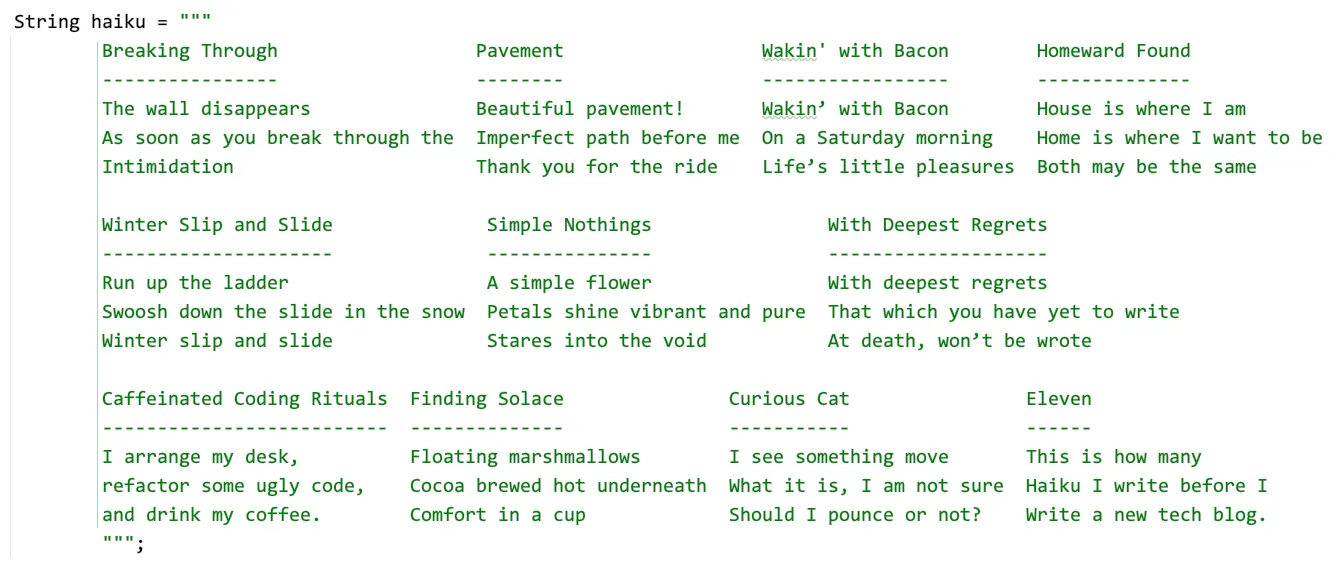Groovy™ Haiku processing
Published: 2023-03-25 07:22PM
This blog looks at some Groovy solutions for the examples in the Haiku for Java using Text Blocks post by Donald Raab. In his example, he is making use of Java text blocks, but Groovy already supports similar functionality with its multi-line strings, so we won’t elaborate further on that aspect.
Here is some of Donald’s creative writing:

In his examples, he processes those examples in various ways. We’ll look at doing the same examples using Groovy.
There has also been an excellent follow-on discussion of these examples in a recent JEP Café video by José Paumard.
Example 1: Finding the distinct letters
In this example, we want to see all the individual letters used in the haiku text. We will disregard any punctuation characters and convert all letters to lowercase since we don’t care about the distinction of case.
Here is the Groovy code:
assert haiku.codePoints().toArray()
.findAll(Character::isAlphabetic)
.collect(Character::toLowerCase)
.toUnique()
.collect(Character::toString)
.join() == 'breakingthoupvmwcdflsy'We made a slight change compared to what is in the blog and video.
We used codePoints() instead of chars().
While Donald’s current haiku text doesn’t contain any surrogate pairs,
we might as well be ready to handle any if they appear in the future.
You can see here that the following smiley face emoji is encoded
with two characters:
assert "😃".codePoints().mapToObj(Character::toString).toList()[0].size() == 2And we are sure it’s only a matter of time before such symbols start appearing more frequently in someone’s haiku.
Example 2: Splitting letters into unique and duplicate partitions
In the next example, we want to count the number of occurrences of each letter and distinguish between letters which are duplicated multiple times and any letters which might occur only once.
We are going to use a map to store letters seen (the key) and the number of times they occur (the value). We’ll create a condition which is true for the map entries which are seen only once.
var uniqueAndDuplicatePartitions = e -> e.value == 1We use Groovy’s countBy method to create our map and then the split
method with our previous condition. This partitions the map into the unique
and duplicate sets.
assert haiku.codePoints().toArray()
.findAll(Character::isAlphabetic)
.collect(Character::toLowerCase)
.collect(Character::toString)
.countBy{ it }
.split(uniqueAndDuplicatePartitions)
*.size() == [0, 22]When we check the sizes of the two sets, we discover that no letters occur only once and that all letters are duplicated.
Example 3: Finding the top used letters
Our final example is a variant of the previous example. Instead of just finding unique and duplicate characters, we want to find the three most frequently occurring letters.
Like before, we need a condition. This time, once that we will use for sorting (in reverse order):
var byCountDescending = e -> -e.valueNow, we just sort using our condition and take the first 3.
assert haiku.codePoints().toArray()
.findAll(Character::isAlphabetic)
.collect(Character::toLowerCase)
.collect(Character::toString)
.countBy{ it }
.sort(byCountDescending)
.take(3) == [e:94, t:65, i:62]Example 3: Other variations
We can also use Eclipse Collections for this:
var top3 = Strings.asCodePoints(haiku)
.select(Character::isAlphabetic)
.collectInt(Character::toLowerCase)
.collect(Character::toString)
.toBag()
.topOccurrences(3)
[e:94, t:65, i:62].eachWithIndex{ k, v, i ->
assert top3[i] == PrimitiveTuples.pair(k, v)
}Using the Bag and its topOccurrences method have done much of the hard work for us.
In fact, this solution also has a behavioral difference in the presence of ties which
we’ll come back to later.
We can of course use the Stream API as is done in both the blog and video. Here is the Groovy equivalent:
assert haiku.codePoints()
.filter(Character::isAlphabetic)
.map(Character::toLowerCase)
.mapToObj(Character::toString)
.collect(Collectors.groupingBy(
Function.identity(),
Collectors.counting()
))
.entrySet()
.stream()
.sorted(Map.Entry.comparingByValue().reversed())
.limit(3)
.toList()
.collectEntries() == [e:94, t:65, i:62]The video makes the point that the above code is quite technical in nature in that you need to keep track of how we are using the map to model our problem domain in order to understand what each processing step is doing.
It suggests using records to better capture a little domain model and make our code more intuitive. Let’s look at doing the same thing on Groovy.
Here are three records that we will use:
record Letter(int codePoint) {
Letter(int codePoint) {
this.codePoint = Character.toLowerCase(codePoint)
}
}
record LetterCount(int count) implements Comparable<LetterCount> {
int compareTo(LetterCount other) {
Integer.compare(this.count, other.count)
}
}
record LetterByCount(Letter letter, LetterCount count) {
LetterByCount(Letter letter, Integer count) {
this(letter, new LetterCount(count))
}
static Comparator<? super LetterByCount> comparingByCount() {
Comparator.comparing(LetterByCount::count)
}
}Now our collecting and sorting steps are in terms of our domain model, and it is a little easier to understand:
assert haiku.codePoints().toArray()
.findAll(Character::isAlphabetic)
.collect(Letter::new)
.countBy{ it }
.collect(LetterByCount::new)
.toSorted(LetterByCount.comparingByCount().reversed())
.take(3)
*.letter
*.codePoint
.collect(Character::toString) == ['e', 't', 'i']The video also goes into an interesting difference with the Eclipse Collections
version. The topOccurrences method from the bag class handles ties and in
the case of a tie returns both occurrences. There aren’t any ties in the top
3 occurrences, nor indeed the top 14, but if you call topOccurrences(15),
then 16 occurrences are returned. We can follow the suggestion in the video
which gives us the following Groovy code:
var byCountReversed = e -> -e.key
assert haiku.codePoints().toArray()
.findAll(Character::isAlphabetic)
.collect(Character::toLowerCase)
.collect(Character::toString)
.countBy{ it }
.groupBy{ k, v -> v }
.sort(byCountReversed)
.take(15)
*.value.sum()*.key == ['e', 't', 'i', 'a',
'o', 'n', 's', 'r',
'h', 'd', 'w', 'l',
'u', 'm', 'p', 'c']We are essentially doing two grouping statements, the first as part of countBy
and then a subsequent groupBy on values. As we can see, if we look at the top
15 occurrences, 16 values are returned.
